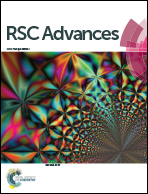A multiple-responsive water-soluble [3]pseudorotaxane constructed by pillar[5]arene-based molecular recognition and disulfide bond connection†
Abstract
A multiple-responsive water-soluble [3]pseudorotaxane was constructed by water-soluble pillar[5]arene-based molecular recognition and disulfide bond connection, showing multiple-responsive properties coming from non-covalent interactions and the disulfide bond.
![Graphical abstract: A multiple-responsive water-soluble [3]pseudorotaxane constructed by pillar[5]arene-based molecular recognition and disulfide bond connection](/en/Image/Get?imageInfo.ImageType=GA&imageInfo.ImageIdentifier.ManuscriptID=C5RA22811E&imageInfo.ImageIdentifier.Year=2016)

 Please wait while we load your content...
Please wait while we load your content...